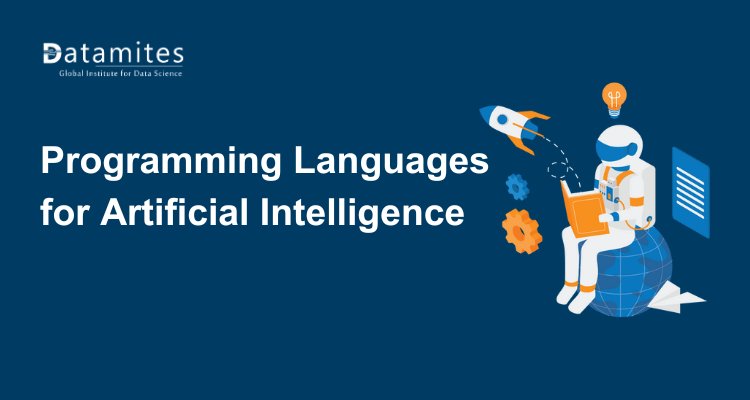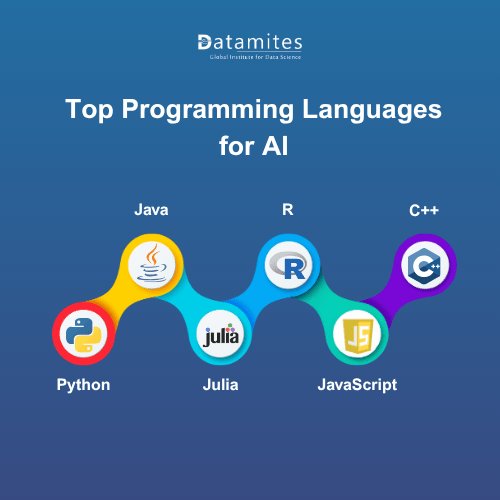Best Programming Languages for Artificial Intelligence Development
Selecting the best programming language for artificial intelligence development depends on project goals, performance needs, and developer expertise. Understanding the strengths of each language helps developers build efficient and scalable AI systems tailored to their specific needs.

Artificial Intelligence (AI) is revolutionizing nearly every industry from healthcare and finance to transportation and entertainment. As more companies integrate AI into their operations, the demand for skilled developers who understand the right tools, especially programming languages, is soaring. Choosing the best programming language is critical for building efficient, scalable, and maintainable AI systems.
Whether you're a beginner starting your journey through an artificial intelligence course or an experienced developer aiming to expand your skill set, understanding the strengths and limitations of each programming language will help you make informed decisions.
Why Choosing the Right Programming Language Matters in AI Development
Different AI applications require different tools, and the choice of programming language can significantly impact the effectiveness of a project. While some languages are better suited for statistical modeling, others excel in developing neural networks or building real-time AI systems. Selecting the right programming language can:
- Accelerate development time
- Improve model accuracy and performance
- Ensure compatibility with leading AI libraries and frameworks
- Enhance overall productivity and scalability
According to a report by Grand View Research, the global artificial intelligence industry is projected to reach a revenue of approximately USD 1.81 trillion (US$ 1,811,747.3 million) by 2030, underscoring the growing importance of efficient and scalable AI development practices.
Key Factors to Consider When Choosing a Language for Artificial Intelligence
Different AI applications require different tools. While some languages are better suited for statistical modeling, others shine in building neural networks or real-time AI systems. Selecting the right programming language can:
- Library and Framework Support: A rich set of AI libraries speeds up development.
- Performance: Execution speed is vital for large-scale and real-time AI tasks.
- Community and Documentation: Strong community support helps with troubleshooting and continuous learning.
- Ease of Learning: Beginners may prefer languages with simpler syntax and robust learning resources.
- Integration: The language should integrate easily with other systems and data pipelines.
As the AI market continues to experience significant growth, choosing a programming language that meets key development criteria is crucial for creating efficient and scalable AI solutions. According to ABI Research, the Artificial Intelligence (AI) software market was valued at approximately USD 122 billion in 2024, underscoring the rising demand for intelligent technologies across a wide range of industries.
Refer these below articles:
- AI in Everyday Life
- Understanding Machine Learning: Basics for Beginners
- Top 10 Real-World Applications of Artificial Intelligence
Top Programming Languages for Artificial Intelligence Development
Choosing the right programming language is crucial for effective artificial intelligence development. Here’s a look at the top languages that power today’s intelligent systems.
Python
Python is arguably the most popular programming language for AI development. Known for its simplicity and readability, Python is beginner-friendly and ideal for rapid prototyping.
Why Python Excels in AI:
- Comprehensive Libraries: TensorFlow, PyTorch, Scikit-learn, Keras, and NLTK cover almost every AI domain including deep learning, machine learning, and natural language processing.
- Active Community: With millions of developers, it's easy to find solutions and resources.
- Integration: Easily integrates with web frameworks, APIs, and cloud platforms.
R
R is a statistical computing language ideal for data analysis, machine learning, and visualization.
Why R is Relevant in AI:
- Statistical Modeling: Built-in functions for regression, classification, and clustering.
- Data Visualization: ggplot2 and Shiny make it easy to present data insights.
- Research-Oriented: Frequently used in academic and healthcare sectors for AI research.
Java
Java is a powerful, object-oriented programming language that’s widely used in enterprise-level AI applications.
Why Java Stands Out:
- Scalability: Ideal for building large-scale AI solutions.
- Cross-Platform: Write once, run anywhere capability.
- Libraries: Libraries like Deeplearning4j, Weka, and MOA support AI functions.
C++
C++ is known for its high performance and control over system resources, making it suitable for resource-constrained environments.
C++ in AI:
- Speed: Excellent for time-sensitive applications like robotics and video games.
- Memory Management: Offers detailed control for optimization.
- Compatibility: Used in AI engines and embedded systems.
Julia
Julia is a high-level, high-performance programming language designed specifically for numerical computing.
What Makes Julia Unique:
- Speed Comparable to C++: Great for high-performance AI tasks.
- Mathematical Syntax: Intuitive for users with a background in mathematics or physics.
- Growing Ecosystem: Libraries like Flux.jl and MLJ.jl support machine learning and deep learning.
JavaScript
JavaScript may not be the first language that comes to mind for AI, but it has growing importance, especially in browser-based applications.
Why JavaScript Matters:
- Front-End AI: Enables AI models to run directly in the browser.
- Libraries: TensorFlow.js, Brain.js bring machine learning to the web.
- Real-Time Interaction: Ideal for chatbots, visual recognition, and dynamic UI elements.

Which Language Should You Choose?
The best programming language for AI development depends on your specific goals:
- Beginner-Friendly: Start with Python. It’s well-supported, widely used, and thoroughly covered in almost every artificial intelligence.
- Statistical Analysis: Choose R for data-driven research and insights.
- Enterprise Development: Java offers robustness and scalability.
- Performance-Critical Tasks: C++ delivers control and speed.
- Cutting-Edge Research: Julia offers unmatched numerical precision.
- Web-Based AI: JavaScript allows for seamless integration into web apps.
Refer these below articles:
There’s no one-size-fits-all language when it comes to AI development. As you move forward in your AI course or career, you'll likely find that different problems call for different tools and learning multiple languages can be a big advantage. In fact, according to Statista, the AI market grew to over 184 billion U.S. dollars in 2024. That's nearly a 50 billion dollar increase from just the year before. It’s a clear sign of how fast the field is growing and how important it is to stay adaptable.
The Artificial Intelligence course in Hyderabad is expanding and evolving, creating a wealth of opportunities for developers around the world. Choosing the right programming language is a crucial first step in building effective AI solutions. Whether you're just beginning your AI journey or aiming to specialize in a specific area, aligning your goals with the capabilities of the right language can significantly impact your success.
DataMites is a globally recognized training institute offering courses in data science, Artificial Intelligence, machine learning, and Python programming. Accredited by bodies like IABAC and NASSCOM FutureSkills, DataMites stands out for its strong presence in major Indian cities, including Artificial Intelligence Institute in Hyderabad, Bangalore, Chennai, Pune, Ahmedabad, Coimbatore and Mumbai. The Courses combine theory with practical training, featuring capstone projects, internships, and placement assistance, including resume building and interview preparation.





